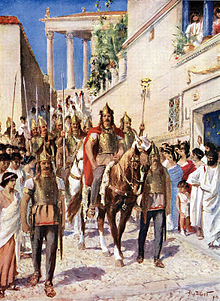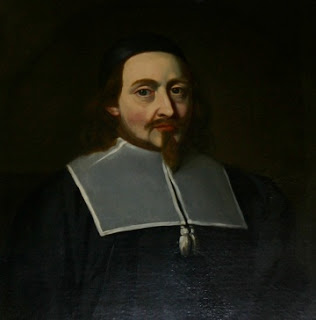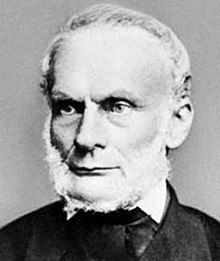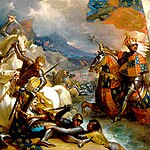August 24 is the 236th day of the year (237th in leap years) in the Gregorian calendar. There are 129 days remaining until the end of the year.
Holidays
- Christian feast day:
- Earliest date on which Notting Hill Carnival can fall, while August 31 is the latest; celebrated on the last Monday in August and the day before. (Notting Hill)
- Flag Day (Liberia)
- Independence Day or Den’ Nezalezhnosti, celebrates the independence of Ukraine from the Soviet Union in 1991.
- National Waffle Day (United States)
- Nostalgia Night (Uruguay)
- Willka Raymi (Cusco, Peru)
- Kobe Bryant Day (Los Angeles, California)
History
In 49 BC, Julius Caesar‘s general Gaius Scribonius Curio is defeated in the Battle of the Bagradas (49 BC) by the Numidians under Publius Attius Varus and King Juba ofNumidia. Curio commits suicide to avoid capture.
In 79, Mount Vesuvius erupts. The cities of Pompeii, Herculaneum, and Stabiae are buried in volcanic ash (note: this traditional date has been challenged, and many scholars believe that the event occurred on October 24).
In 367, Gratian, son of Roman Emperor Valentinian I, is named co-Augustus at the age of eight by his father
In 394, The Graffito of Esmet-Akhom, the latest known inscription in Egyptian hieroglyphs, was written.

In 410, The Visigoths under king Alaric I begin to pillage Rome, an event that symbolized the fall of the Western Roman Empire..
In 455, The Vandals, led by king Genseric, begin to plunder Rome. Pope Leo I requests Genseric not destroy the ancient city or murder its citizens. He agrees and the gates of Rome are opened. However, the Vandals loot a great amount of treasure.
In 1185, Sack of Thessalonica by the Normans.
In 1200, King John of England, signer of the first Magna Carta, marries Isabella of Angoulême in Bordeaux Cathedral.
In 1215, Pope Innocent III declares Magna Carta invalid.
The Battle of Blanchetaque was fought on 24 August 1346, during the early stagesof the Hundred Years’ War, between an English army under King Edward III and a French force commanded by Godemar du Fay. The English army had burnt a path of destruction through some of the richest lands in France to within 20 miles (32 km) of Paris, then had marched north, hoping to link up with an allied Flemish army. The French king, Philip VI, garrisoned all of the bridges and fords over the River Sommeand followed the English with his own field army. The area had previously been stripped of food stocks, and the English were essentially trapped. They launched an attack across a tidal ford at Blanchetaque, and after a disorderly mêlée the French blocking force there broke and fled. French casualties were reported as over half of their force, while English losses were light. Two days later, the main army under Philip was defeated at the Battle of Crécy.
In 1349, Six thousand Jews are killed in Mainz after being blamed for the bubonic plague.
In 1391, Jews are massacred in Palma de Mallorca.
In 1456, The printing of the Gutenberg Bible is completed.
In 1482, The town and castle of Berwick upon Tweed is captured from Scotland by an English army
In 1516, The Ottoman Empire under Selim I defeats the Mamluk Sultanate and captures present-day Syria at the Battle of Marj Dabiq.
In 1542, In South America, Gonzalo Pizarro returns to the mouth of the Amazon River after having sailed the length of the great river as far as the Andes Mountains.
In 1561, Willem of Orange marries duchess Anna of Saxony.
In 1572, The slaughter of French Protestants at the hands of Catholics began in Paris on St. Bartholomew’s Day. The killings lasted until October, and claimed some 13,000 victims.
In 1608, The first official English representative to India lands in Surat.
In 1624, Sir Francis Wyatt is officially appointed governor of the royal Virginia Colony. Sir Francis Wyatt organized the General Assembly which had been called in 1619. This was the first legislative body in America. Sir Francis caused its privileges to be embodied in a written constitution, the first of its kind in the New World.

In 1636, Former Massachusetts Governor John Endecott organizes a military force for the Pequot Indian War. Endecott’s instructions were to go to Block Island, where he was to kill all of the Indian men and take captive the women and children. He was then to go to the Pequots on the mainland, where he was to make three demands: first, that the killers of Oldham and the other trader be surrendered; second, that a payment of one thousand fathoms of wampum be made; and third, that some Pequot children be delivered to serve as hostages.
In 1662, The Act of Uniformity requires England to accept the Book of Common Prayer.
In 1682, William Penn receives the area that is now the state of Delaware, and adds it to his colony of Pennsylvania.
In 1690, Job Charnock of the East India Company establishes a factory in Calcutta, an event formerly considered the founding of the city (in 2003 the Calcutta High Court ruled that the city has no birthday).
In 1750, Letizia Bonaparte was born. She would go on to have a son who tended to pose for portraits with his hand stuck into his vest.
In 1781, American Revolutionary War: A small force of Pennsylvania militia is ambushed and overwhelmed by an American Indian group, which forces George Rogers Clark to abandon his attempt to attack Detroit.
In 1812, Peninsular War: A coalition of Spanish, British, and Portuguese forces succeed in lifting the two-and-a-half-year-long Siege of Cádiz.
In 1814, British troops invade Washington, D.C. and during the Burning of Washington the White House, the Capitol and many other buildings are set ablaze.
In 1815, The modern Constitution of the Netherlands is signed.
In 1816, The Treaty of St. Louis is signed in St. Louis, Missouri.
In 1820, Constitutionalist insurrection at Oporto, Portugal.
In 1821, The Treaty of Córdoba is signed in Córdoba, now in Veracruz, Mexico, concluding the Mexican War of Independence from Spain.

In 1832, Nicolas Léonard Sadi Carnot, French physicist and engineer (b. 1796) dies during a cholera epidemic in 1832, at the age of 36. He was a French military engineer and physicist, often described as the “father of thermodynamics“. In his only publication, the 1824 monograph Reflections on the Motive Power of Fire, Carnot gave the first successful theory of the maximum efficiency of heat engines. Carnot’s work attracted little attention during his lifetime, but it was later used by Rudolf Clausius and Lord Kelvin to formalize the second law of thermodynamics and define the concept of entropy.

Carnot sought to answer two questions about the operation of heat engines: “Is the work available from a heat source potentially unbounded?” and “Can heat engines in principle be improved by replacing the steam with some other working fluid or gas?” He attempted to answer these in a memoir, published as a popular work in 1824 when he was only 28 years old. It was entitled Réflexions sur la Puissance Motrice du Feu (“Reflections on the Motive Power of Fire”). The book was plainly intended to cover a rather wide range of topics about heat engines in a rather popular fashion; equations were kept to a minimum and called for little more than simple algebra and arithmetic, except occasionally in the footnotes, where he indulged in a few arguments involving some calculus. He discussed the relative merits of air and steam as working fluids, the merits of various aspects of steam engine design, and even included some ideas of his own regarding possible improvements of the practical nature. The most important part of the book was devoted to an abstract presentation of an idealized engine that could be used to understand and clarify the fundamental principles that are generally applied to all heat engines, independent of their design.
Perhaps the most important contribution Carnot made to thermodynamics was his abstraction of the essential features of the steam engine, as they were known in his day, into a more general and idealized heat engine. This resulted in a model thermodynamic system upon which exact calculations could be made, and avoided the complications introduced by many of the crude features of the contemporary steam engine. By idealizing the engine, he could arrive at clear and indisputable answers to his original two questions.
Because of the contagious nature of cholera, many of Carnot’s belongings and writings were buried together with him after his death. As a consequence, only a handful of his scientific writings survived.
In 1847, Charlotte Bronte finishes manuscript of “Jane Eyre”. It was published on 16 October 1847, by Smith, Elder & Co. of London, England, under the pen name “Currer Bell”. The first American edition was published the following year by Harper & Brothers of New York.

In 1853, A legend associates the creation of potato chips with Saratoga Springs, New York, decades later. By the late nineteenth century, a popular version of the story attributed the dish to George Crum, a half-black, half-Native American cook at Moon’s Lake House, who was trying to appease an unhappy customer on 24 August 1853. The customer kept sending his French-fried potatoes back, complaining that they were too thick. Frustrated, he sliced the potatoes razor thin, fried them until crisp and seasoned them with extra salt. To Crum’s surprise, the customer loved them. They soon became called “Saratoga Chips”, a name that persisted into at least the mid-twentieth century. A version of this story popularized in a 1973 national advertising campaign by St. Regis Paper Company, which manufactured packaging for chips, said that Crum’s customer was Cornelius Vanderbilt. Crum was renowned as a chef and by 1860 owned his own lakeside restaurant, Crum’s House.
In 1857, The Panic of 1857 begins, setting off one of the most severe economic crises in United States history.
In 1858, Richmond “Daily Dispatch” reports 90 blacks arrested for learning.
In 1869, The Waffle Iron was patented by Cornelius Swarthout. The next day, the Waffle Whiffer snatches all the waffles made.
In 1870, The Wolseley expedition reaches Manitoba to end the Red River Rebellion.
In 1875, Captain Matthew Webb became first person to swim the English Channel

In 1888, Rudolf Clausius, German physicist and mathematician (b. 1822) dies. He was a German physicist and mathematician and is considered one of the central founders of the science of thermodynamics. By his restatement of Sadi Carnot‘s principle known as the Carnot cycle, he put the theory of heat on a truer and sounder basis. His most important paper, On the Moving Force of Heat, published in 1850, first stated the basic ideas of the second law of thermodynamics. In 1865 he introduced the concept of entropy. In 1870 he introduced the virial theorem which applied to heat.
Clausius’s PhD thesis concerning the refraction of light proposed that we see a blue sky during the day, and various shades of red at sunrise and sunset (among other phenomena) due to reflection and refraction of light. Later, Lord Rayleigh would show that it was in fact due to the scattering of light, but regardless, Clausius used a far more mathematical approach than some have used.
His most famous paper, “Über die bewegende Kraft der Wärme” (“On the Moving Force of Heat and the Laws of Heat which may be Deduced Therefrom“) was published in 1850, and dealt with the mechanical theory of heat. In this paper, he showed that there was a contradiction between Carnot‘s principle and the concept of conservation of energy. Clausius restated the two laws of thermodynamicsto overcome this contradiction (the third law was developed by Walther Nernst, during the years 1906–1912). This paper made him famous among scientists.
Clausius’ most famous statement of the second law of thermodynamics was published in German in 1854,and in English in 1856.
Heat can never pass from a colder to a warmer body without some other change, connected therewith, occurring at the same time.
During 1857, Clausius contributed to the field of kinetic theory after refining August Krönig‘s very simple gas-kinetic model to include translational, rotational and vibrational molecular motions. In this same work he introduced the concept of ‘Mean free path‘ of a particle.
In 1891, Thomas Edison patents the motion picture camera.
In 1894, Congress passes the first graduated income tax law, which is declared unconstitutional the next year.
In 1898, Count Muravyov, Foreign Minister of Russia presents a rescript that convoked the First Hague Peace Conference.
In 1909, Workers start pouring concrete for the Panama Canal.
In 1912, Territory of Alaska organized.
In 1912, The U.S. Post Office got heavy this day, by abolishing its rule that only parcels up to four pounds could be sent through the system.
In 1912, US passes Anti-gag law, federal employees right to petition the govt.
In 1914, World War I: German troops capture Namur.
In 1914, World War I: The Battle of Cer ends as the first Allied victory in the war.
In 1921, British airship R-38 crashes in Humber; 44 die. England: AR-2 British dirigible, broke in two on trial trip near Hull; 62 died.
In 1929, Second day of two-day Hebron massacre during the 1929 Palestine riots: Arab attacks on the Jewish community in Hebron in the British Mandate of Palestine, result in the death of 65–68 Jews and the remaining Jews being forced to leave the city.
In 1931, France and the Soviet Union sign a neutrality/no attack treaty.
In 1931, Resignation of the United Kingdom’s Second Labour Government. Formation of the UK National Government.
In 1932, Amelia Earhart becomes the first woman to fly across the United States non-stop (from Los Angeles to Newark, New Jersey).
In 1933, The Crescent Limited train derails in Washington, D.C., after the bridge it is crossing is washed out by the 1933 Chesapeake–Potomac hurricane.
In 1936, The Australian Antarctic Territory is created.
In 1936, FDR gives FBI authority to pursuit fascists & communists.
In 1937, Spanish Civil War: the Basque Army surrenders to the Italian Corpo Truppe Volontarie following the Santoña Agreement.
In 1937, Spanish Civil War: Sovereign Council of Asturias and León is proclaimed in Gijón.
In 1939, Nazi Germany and the Soviet Union signed a 10-year nonaggression pact.
In 1941, Adolf Hitler orders the cessation of Nazi Germany‘s systematic T4 euthanasia program of the mentally ill and the handicapped due to protests, although killings continue for the remainder of the war.
1942, World War II: The Battle of the Eastern Solomons. Japanese aircraft carrier Ryūjō is sunk and US carrier USS Enterprise heavily damaged. This is the third carrier-versus-carrier battle of the war, U.S. naval forces defeat a Japanese force attempting to screen reinforcements for the Guadalcanal fighting. The Second Naval Battle of Guadalcanal spelled the difference between victory and defeat for the United States in the Pacific war.
In 1944, World War II: Allied troops begin the attack on Paris.
In 1949, The treaty creating the North Atlantic Treaty Organization goes into effect.
In 1950, Edith Sampson becomes the first black U.S. delegate to the United Nations.
In 1954, The Communist Control Act goes into effect, outlawing the American Communist Party.
In 1954, Getúlio Dornelles Vargas, president of Brazil, commits suicide and is succeeded by João Café Filho.
In 1959, Three days after Hawaiian statehood, Hiram L. Fong was sworn in as the first Chinese-American U.S. senator while Daniel K. Inouye was sworn in as the first Japanese-American U.S. representative.
In 1960, 60 people die when bus plunges off bridge into Turvo River, Brazil.
In 1963, Buddhist crisis: As a result of the Xá Lợi Pagoda raids, the US State Department cables the United States Embassy, Saigon to encourage Army of the Republic of Vietnam generals to launch a coup against President Ngô Đình Diệm if he did not remove his brother Ngô Đình Nhu.
In 1967, Led by Abbie Hoffman, the Youth International Party temporarily disrupts trading at the New York Stock Exchange by throwing dollar bills from the viewing gallery, causing trading to cease as brokers scramble to grab them.
In 1968, France exploded a hydrogen bomb at a South Pacific testing ground on Mururoa and became the world’s fifth thermonuclear power.
In 1969, Peru nationalizes US oil interests.
In 1970, a bomb planted by anti-war extremists exploded at the University of Wisconsin’s Army Math Research Center in Madison, killing 33-year-old researcher Robert Fassnacht.
In 1981, Mark David Chapman is sentenced to 20 years to life in prison for murdering John Lennon. Over the next few months, Chapman would claim many times to have been beaten by fellow inmates, some of whom allegedly tried to kill him with items like scissors.
In 1983, Corazon Aquino, widow of Philippine opposition leader Benigno S. Aquino Jr., returned to her homeland for her husband’s funeral, rejecting President Ferdinand E. Marcos’ denial that his government had any part in Aquino’s assassination.
In 1984, On the heels of the Republican convention, Democrat Walter F. Mondale said the proceedings had demonstrated that President Reagan represented the party of the rich, while Reagan questioned Mondale’s commitment to a strong defense.
In 1986, Financially troubled Frontier Airlines shut down, stranding thousands of passengers throughout the West.
In 1987, PBS is threatened with a lawsuit if they use a banana to demonstrate how to use a condom during an AIDS special. It’s not a fundamentalist group protesting, but Robert Moore, president of the International Banana Association.
In 1987, A military jury in Quantico, Virginia, sentenced Marine Sergeant Clayton Lonetree to 30 years in prison for disclosing US secrets to the Soviet Union. (The sentence was later reduced; with additional time off for good behavior, Lonetree ended up serving eight years in a military prison.)
In 1987, A federal appeals court in Cincinnati ruled public schools can require students to study textbooks not accepted by religious fundamentalists.
In 1988, Democratic presidential nominee Michael Dukakis picked up the endorsement of the AFL-CIO while Republican nominee George Bush campaigned in California with President Ronald Reagan.
In 1989, Colombian drug barons declare “total war” on the Colombian government.
In 1989, Cincinnati Reds manager Pete Rose is banned from baseball for gambling by Commissioner A. Bartlett Giamatti.
In 1989, Tadeusz Mazowiecki is chosen as the first non-communist Prime Minister in Central and Eastern Europe.
In 1990, Irish hostage Brian Keenan was released by his captors in Lebanon after being held more than four years.
In 1990, Iraqi troops surrounded foreign missions in Kuwait.
In 1991, Mikhail Gorbachev resigns as head of the Communist Party of the Soviet Union.
In 1991, Ukraine declares itself independent from the Soviet Union.
In 1992, Hurricane Andrew makes landfall just south of Miami as a Category 5 hurricane.
In 1994, Initial accord between Israel and the PLO about partial self-rule of the Palestinians on the West Bank.
In 1995, Microsoft Windows 95 was released to the public in North America. The most over-hyped operating system upgrade ever was released: Microsoft Windows 95. Windows 95 was rumored to be run under MS DOS 7 in some computer magazines. Microsoft also purchased the rights to use the Rolling Stones’ “Start Me Up” for a reported $12 million.
In 1996, Four women began two days of academic orientation at The Citadel; they were the first female cadets admitted to the South Carolina military school since Shannon Faulkner.
In 1997, Gordon Spence discovers 2^2976221 – 1, the 36th known Mersenne prime number. It takes his Pentium 100 PC fifteen days to prove the number is (at the time) the largest known prime number. It is 895,932 digits in length. If printed out the number will stretch for 1.4 miles or if spoken 8 hours a day will take 28 days to complete.
In 1998, First radio-frequency identification (RFID) human implantation tested in the United Kingdom.
In 1998, The United States and Britain agreed to allow two Libyan suspects wanted in the bombing of Pan Am flight 103 to be tried in a Scottish court sitting in the Netherlands.
In 1998, A federal court rejected the Census Bureau’s plans to use statistical sampling for the 2000 census, a decision later upheld by the Supreme Court.
In 2001, Air Transat Flight 236 runs out of fuel over the Atlantic Ocean (en route to Lisbon from Toronto) and makes an emergency landing in the Azores.
In 2004, Eighty-nine passengers die after two airliners explode after flying out of Domodedovo International Airport, near Moscow. The explosions are caused by suicide bombers (reportedly female) from the Russian Republic of Chechnya.
In 2006, The International Astronomical Union (IAU) redefines the term “planet” such that Pluto is now considered a dwarf planet.
In 2010, In San Fernando, Tamaulipas, Mexico, 72 illegal immigrants are killed by Los Zetas and eventually found dead by Mexican authorities.
In 2016, An earthquake strikes Central Italy with a magnitude of 6.2, with aftershocks felt as far as Rome and Florence.


